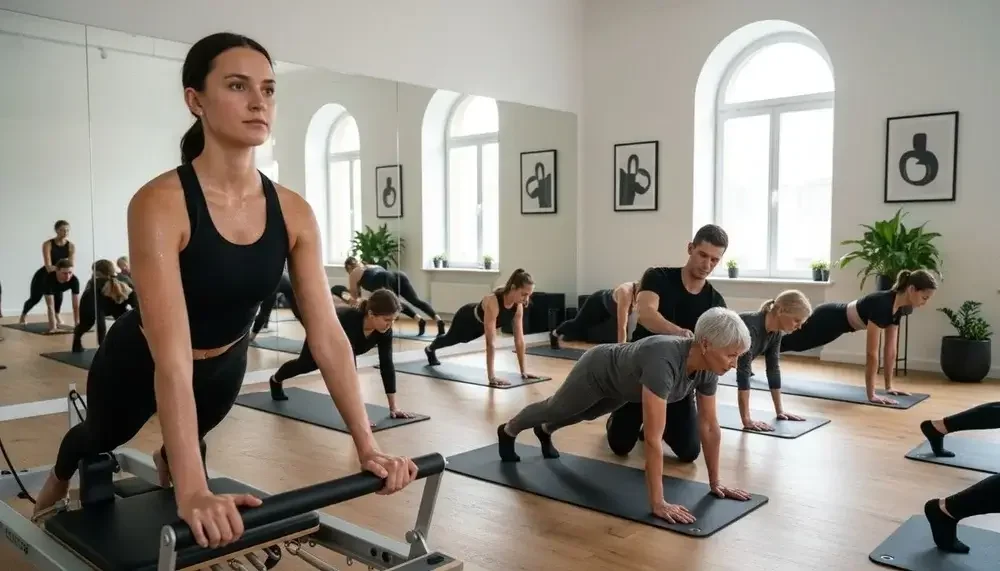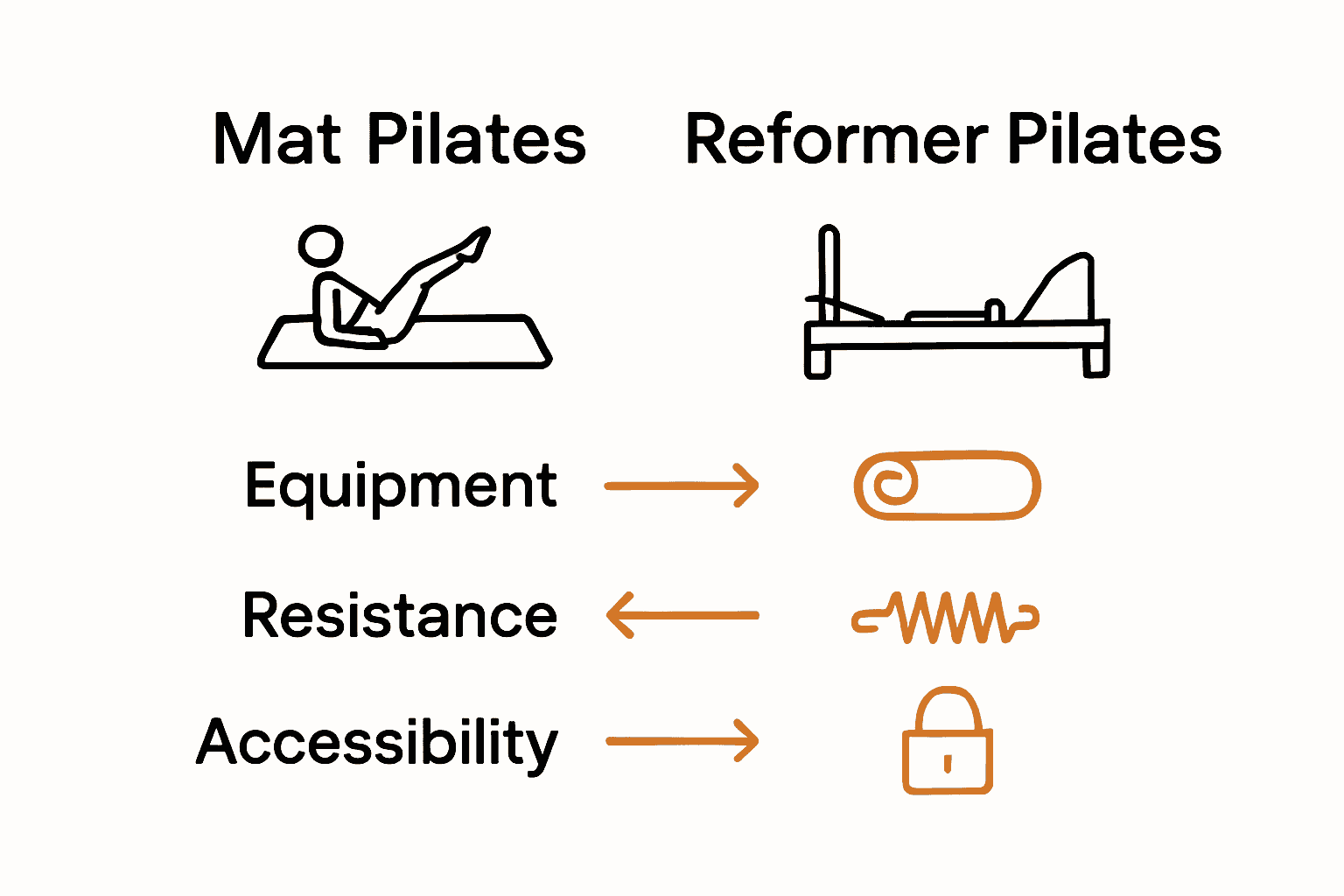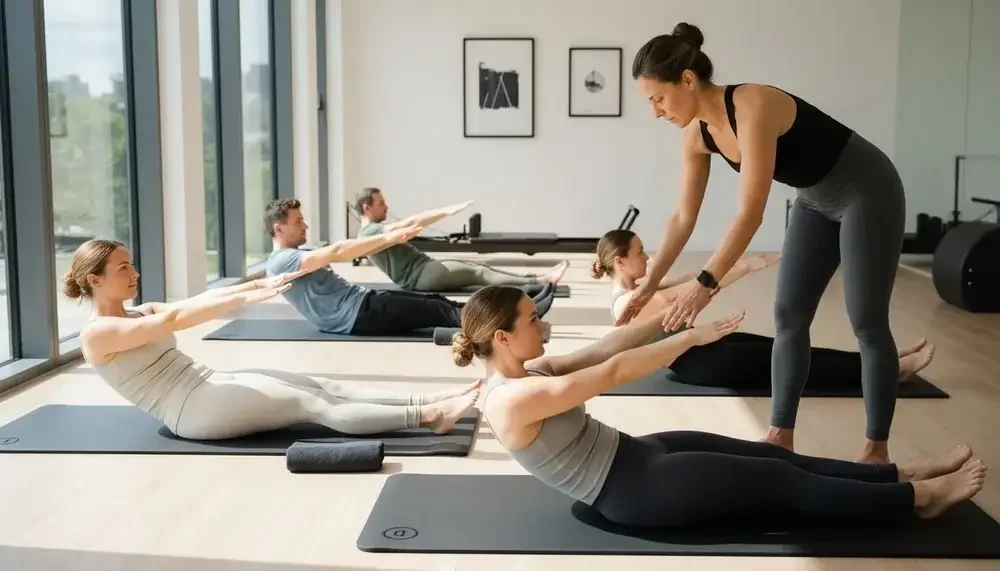Complete Guide to Types of Pilates Practices
Heather Rice
Over 12 million people practice Pilates worldwide, yet many are surprised by how much more it offers than simple stretching or core work. Beyond gentle movements, Pilates is built on six core principles that shape every session and create lasting changes in posture, strength, and mental focus. By understanding these fundamentals, you can unlock a more intentional, effective way to move and feel stronger from the inside out.
Table of Contents
Key Takeaways
| Point | Details |
|---|---|
| Core Principles | Pilates is built on six fundamental principles: Breathing, Control, Concentration, Centering, Flow, and Precision, emphasizing quality of movement over quantity. |
| Method Variations | There are several Pilates methods, including Mat Pilates and Reformer Pilates, each offering different equipment and focus areas to suit various fitness goals. |
| Choosing a Practice | Selecting the right Pilates method depends on individual fitness goals, levels, and any physical limitations, with Mat Pilates being ideal for beginners. |
| Hybrid Approaches | Innovative styles like Stott Pilates, Tangolates, and Aerial Pilates merge traditional Pilates with other movements, providing unique workout experiences. |
What Is Pilates? Core Principles Explained
Pilates is a holistic exercise method developed in the early 20th century by Joseph Pilates, designed to strengthen the body through controlled, precise movements that emphasize core engagement. According to sport-exercise.ed.ac.uk, this practice focuses on creating balanced muscle development and overall fitness by integrating mind and body.
At its core, Pilates revolves around six fundamental principles that transform it from a simple workout into a comprehensive wellness approach. As fleurwellbeing.com.au explains, these principles extend far beyond the studio and can become an integral part of one's lifestyle:
Breathing: Using intentional, deep breathing to support movement and enhance body awareness
Control: Executing each movement with precision and deliberate muscle engagement
Concentration: Maintaining mental focus throughout the exercise routine
Centering: Developing core strength as the foundation of all movement
Flow: Creating smooth, graceful transitions between exercises
Precision: Performing movements with exactness and proper alignment
Unlike traditional fitness approaches that prioritize repetitions, Pilates emphasizes quality of movement over quantity. The method aims to develop long, lean muscles while improving flexibility, posture, and overall body mechanics. Discover our comprehensive guide on Pilates breathing techniques to understand how breathwork plays a crucial role in mastering this transformative practice.
Comparing Major Types of Pilates Methods
Pilates has evolved significantly since its original development, branching into multiple specialized methods that cater to different fitness goals and practitioner needs. While the core principles remain consistent, each variation offers unique approaches to movement, alignment, and body conditioning.
Here's a comparison of the main types of Pilates methods:
| Method | Equipment Used | Focus Areas | Typical Benefits |
|---|---|---|---|
| Mat Pilates | Floor mat | Core strength Form Flexibility |
Beginner-friendly Minimal equipment |
| Reformer Pilates | Reformer machine (springs, carriage) | Resistance Advanced movement Muscle targeting |
Greater versatility Full-body conditioning |
| Contemporary Pilates | Mat or specialized apparatus |
Science-based rehab Modular exercises |
Adaptable for all levels |
| Clinical Pilates | Mat Reformer Physical therapy tools |
Rehab Posture Injury prevention |
Supports injury recovery |
| Tangolates | Mat<br>Partner<br>Dance apparatus | Dance integration<br>Aerobic<br>Coordination | Fun<br>Social<br>Cardio benefits |
Classical Pilates remains closest to Joseph Pilates' original method, emphasizing precise movements performed on specialized equipment like the Reformer, Cadillac, and Wunda Chair. By contrast, Wikipedia notes that Stott Pilates represents a contemporary approach that focuses on maintaining the natural curve of the spine, with an enhanced emphasis on core stability and neuromuscular performance.
Some fascinating specialized Pilates variations include:
Mat Pilates: Performed entirely on the floor using body weight and minimal equipment
Reformer Pilates: Utilizes a sliding platform with adjustable tension springs
Contemporary Pilates: Integrates modern exercise science and rehabilitation principles
Clinical Pilates: Designed specifically for injury rehabilitation and physical therapy
Interestingly, some methods blend Pilates with other movement disciplines. According to Wikipedia, Tangolates uniquely combines elements of tango dancing and Pilates, incorporating partner work and aerobic components typically performed on specialized apparatus or mats. Learn more about different Pilates styles in our comprehensive Pilates guide to discover which approach might best suit your fitness journey.
Mat vs. Reformer Pilates: Key Differences
Pilates practitioners have two primary training methods: Mat Pilates and Reformer Pilates, each offering unique approaches to building strength, flexibility, and body awareness. According to futurefit.co.uk, these methods differ significantly in equipment, resistance, and exercise complexity.
Mat Pilates is the foundational practice that relies entirely on body weight and minimal equipment. Performed on a simple exercise mat, this method emphasizes core engagement, precise movements, and developing intrinsic muscle strength. Practitioners use their own body weight as resistance, making it an accessible entry point for beginners and a powerful workout for advanced students.
In contrast, Reformer Pilates introduces a specialized machine with adjustable springs, pulleys, and a sliding carriage that dramatically expands exercise possibilities. Key differences include:
Resistance Variation: Reformer offers adjustable spring tension
Exercise Complexity: More advanced movements possible on Reformer
Muscle Targeting: Reformer allows more diverse muscle group engagement
Accessibility: Mat Pilates requires less equipment and space
Fleur Wellbeing highlights that both methods share core Pilates principles of precision, control, and breath work. Discover our beginner's guide to Reformer Pilates classes to understand which approach might best suit your fitness goals and current skill level.
Specialty and Hybrid Pilates Styles
Pilates has continuously evolved, giving rise to innovative hybrid styles that blend traditional principles with creative movement approaches. These specialty methods expand the boundaries of classic Pilates, offering practitioners unique and engaging workout experiences that target fitness from multiple perspectives.
According to Wikipedia, Stott Pilates represents a contemporary adaptation that reimagines traditional Pilates through a modern lens. This approach emphasizes precise spinal alignment, incorporating contemporary exercise science principles with a focus on core stability and balanced muscle development. Unlike classical methods, Stott Pilates pays special attention to maintaining the spine's natural curves during movement.
Some fascinating hybrid Pilates styles include:
Barre Pilates: Combines Pilates with ballet-inspired movements
Aerial Pilates: Utilizes suspended hammocks for added resistance and challenge
Cardio Pilates: Integrates high-intensity interval training principles
Water Pilates: Performed in swimming pools for low-impact resistance training
One of the most unique hybrid styles is Tangolates. Wikipedia describes this innovative method as a fusion that blends tango dance movements with Pilates principles, often performed with a partner and incorporating aerobic elements on specialized apparatus. Learn more about unique Pilates fusion styles in our Barre Pilates guide, which explores how different movement disciplines can complement traditional Pilates practice.
Choosing the Right Pilates Practice for You
Selecting the ideal Pilates practice is a personal journey that involves understanding your fitness goals, physical condition, and individual preferences. According to futurefit.co.uk, the right approach depends on your unique fitness objectives and current physical capabilities.
Beginners might find Mat Pilates an excellent starting point, as it requires minimal equipment and focuses on building foundational core strength using body weight. This approach allows practitioners to develop proper form, understand fundamental movements, and build confidence before progressing to more complex practices.
Consider these key factors when choosing your Pilates practice:
Fitness Level: Assess your current strength and flexibility
Personal Goals: Determine whether you seek rehabilitation, strength, flexibility, or overall conditioning
Physical Limitations: Consider any existing injuries or health constraints
Time and Budget: Evaluate equipment requirements and class accessibility
Fleur Wellbeing emphasizes that more advanced practitioners might prefer Reformer Pilates for its adjustable resistance and diverse exercise options. Learn more about the differences between Pilates and yoga in our comprehensive guide to help you make an informed decision about your wellness journey.
Find Your Perfect Pilates Path with Amrita Yoga & Wellness
Choosing the right Pilates practice can feel overwhelming when faced with so many options like Mat, Reformer, or hybrid styles such as Tangolates. You want to strengthen your core, improve flexibility, and enjoy a safe, focused workout that fits your unique goals and fitness level. Finding a supportive community and expert guidance can turn that challenge into an empowering journey.
At Amrita Yoga & Wellness, we understand how important it is to align your practice with your personal needs. Whether you are a beginner ready to explore Mat Pilates or seeking the advanced benefits of Reformer Pilates, our diverse class offerings and knowledgeable instructors are here to help you develop precision, control, and flow. Don’t wait to experience the full benefits of Pilates in a welcoming space where your wellness matters. Start your transformation today by exploring our class schedules, joining workshops, and connecting with a community dedicated to your growth.
Frequently Asked Questions
What are the core principles of Pilates?
The core principles of Pilates include Breathing, Control, Concentration, Centering, Flow, and Precision. These principles emphasize the connection between mind and body for effective movement.
What is the difference between Mat Pilates and Reformer Pilates?
Mat Pilates relies on body weight and does not require specialized equipment, making it beginner-friendly. In contrast, Reformer Pilates uses a machine with adjustable springs, allowing for greater resistance and more complex movements.
What are some specialty and hybrid styles of Pilates?
Specialty and hybrid styles of Pilates include Barre Pilates (combining Pilates with ballet), Aerial Pilates (suspended hammocks), Cardio Pilates (high-intensity intervals), and Tangolates (fusion of tango dance and Pilates). Each offers a unique approach to fitness.
How do I choose the right Pilates practice for my fitness level?
Consider your fitness level, personal goals, physical limitations, and available time and budget. Beginners may prefer Mat Pilates to build foundational strength, while more advanced practitioners might opt for Reformer Pilates for its versatility.













